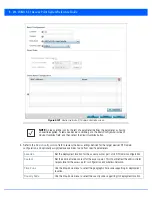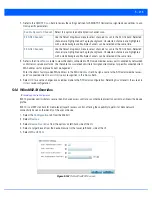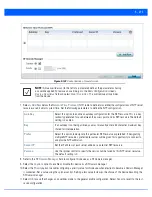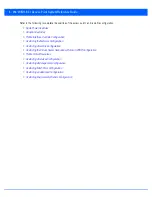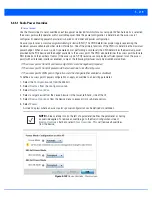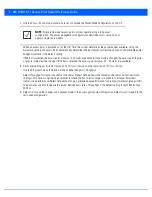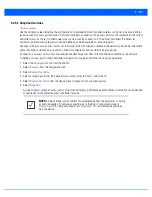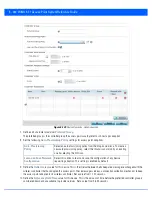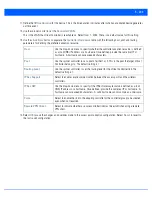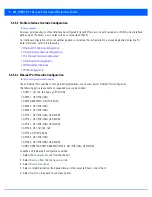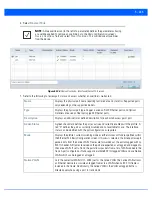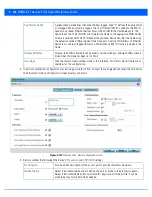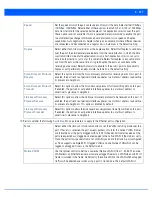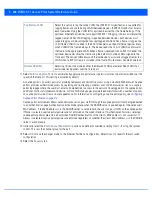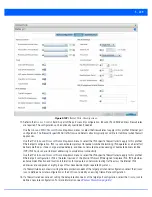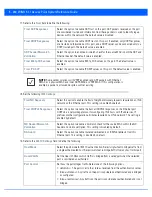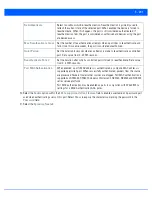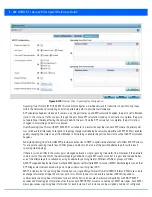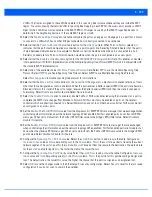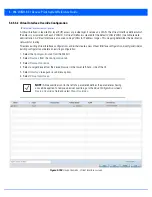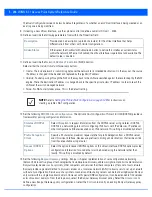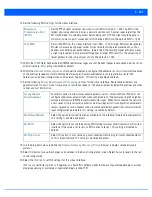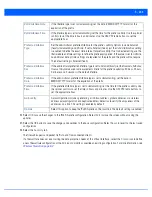
5 - 228 WiNG 5.7.1 Access Point System Reference Guide
11. Select
Enforce Captive Portal
to automatically apply captive portal access permission rules to data transmitted over this
specific Ethernet port. This setting is disabled by default.
A captive portal is an access policy for providing temporary and restrictive access using a standard Web browser. Captive
portals provides authenticated access by capturing and re-directing a wireless user's Web browser session to a captive
portal login page where the user must enter valid credentials to access to the network. Once logged into the captive portal,
additional
Terms and Agreement
,
Welcome
,
Fail
and
No Service
pages provide the administrator with a number of options
on captive portal screen flow and user appearance. For information on configuring a captive portal policy, see
Captive Portal Policies on page 9-2
.
Captive portal enforcement allows wired network users to pass traffic through the captive portal without being redirected
to an authentication page. Authentication instead takes place when the RADIUS server is queried against the wired user's
MAC address. If the MAC address is in the RADIUS server's user database, the user can pass traffic on the captive portal.
If None is selected, captive portal policies are not enforced on the wired interface. If Authentication Failure is selected,
captive portal policies are enforced only when RADIUS authentication of the client’s MAC address is not successful. If
Always is selected, captive portal policies are enforced regardless of whether the client's MAC address is in the RADIUS
server's user database.
12. Optionally select the
Port Channel
Membership
option and define (or override) a setting from 1 - 8 using the spinner
control. This sets the channel group for the port.
13. Select
OK
to save the changes made to the Ethernet Port Basic Configuration. Select
Reset
to revert to the last saved
configuration.
14. Select the
Security
tab.
Tag Native VLAN
Select this option to tag the native VLAN. The IEEE 802.1Q specification is supported for
tagging frames and coordinating VLANs between devices. IEEE 802.1Q adds four bytes to
each frame identifying the VLAN ID for upstream devices that the frame belongs. If the
upstream Ethernet device does not support IEEE 802.1Q tagging, it does not interpret the
tagged frames. When VLAN tagging is required between devices, both devices must
support tagging and be configured to accept tagged VLANs. When a frame is tagged, the
12 bit frame VLAN ID is added to the 802.1Q header so upstream Ethernet devices know
which VLAN ID the frame belongs to. The device reads the 12 bit VLAN ID and forwards
the frame to the appropriate VLAN. When a frame is received with no 802.1Q header, the
upstream device classifies the frame using the default or native VLAN assigned to the
Trunk port. The native VLAN allows an Ethernet device to associate untagged frames to a
VLAN when no 802.1Q frame is included in the frame. This feature is disabled by default.
Allowed VLANs
Selecting
Trunk
as the mode enables the Allowed VLANs parameter. Add VLANs that
exclusively send packets over the listed port.
Summary of Contents for WiNG 5.7.1
Page 1: ...WiNG 5 7 1 ACCESS POINT SYSTEM REFERENCE GUIDE ...
Page 2: ......
Page 3: ...WING 5 7 1 ACCESS POINT SYSTEM REFERENCE GUIDE MN001977A01 Revision A April 2015 ...
Page 4: ...ii WiNG 5 7 1 Access Point System Reference Guide ...
Page 24: ...1 4 WiNG 5 7 1 Access Point System Reference Guide ...
Page 36: ...2 12 WiNG 5 7 1 Access Point System Reference Guide ...
Page 72: ...3 36 WiNG 5 7 1 Access Point System Reference Guide ...
Page 470: ...5 386 WiNG 5 7 1 Access Point System Reference Guide ...
Page 472: ...6 2 WiNG 5 7 1 Access Point System Reference Guide Figure 6 1 Configuration Wireless menu ...
Page 624: ...7 46 WiNG 5 7 1 Access Point System Reference Guide ...
Page 724: ...9 56 WiNG 5 7 1 Access Point System Reference Guide ...
Page 783: ...12 35 Figure 12 46 Device Summary screen 4 Click File Management ...
Page 816: ...12 68 WiNG 5 7 1 Access Point System Reference Guide ...
Page 1006: ...13 190 WiNG 5 7 1 Access Point System Reference Guide ...
Page 1026: ...14 20 WiNG 5 7 1 Access Point System Reference Guide ...
Page 1028: ...A 2 WiNG 5 7 1 Access Point System Reference Guide ...
Page 1089: ......
Page 1090: ...MN001977A01 Revision A April 2015 ...

